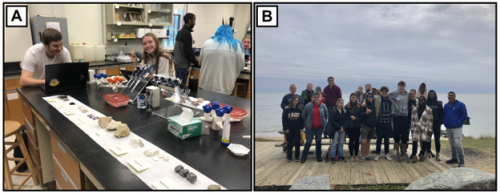From 2018-2020, as a graduate student working with the University of Florida’s Thompson Earth Systems Institute’s founding director Bruce MacFadden, I had the pleasure of helping establish TESI and its Scientist in Every Florida School Program.
I spent a lot of time visiting K-12 classrooms throughout Florida to collaborate with teachers, share my scientific expertise, and serve as a role model in the classroom. These experiences helped me gain confidence in classroom education and taught me how to integrate my research into the broader educational curriculum.
I am now working as a visiting professor in the Environmental Studies department at St. Mary’s College of Maryland, where I have had the opportunity to create three new courses (Earth Systems, AI and Natural History, and Natural History Collections) that all leverage my experiences working with TESI and the Florida Museum of Natural History.

Certainly, the course with the most obvious connection to TESI that I teach is Earth Systems. This course includes a lecture and lab component, allowing for an in-depth review of core concepts in Earth systems science and opportunities for students to engage directly with the content through hands-on activities (Figure 1).
Students explore the interactions between water, air, land, and life to understand the dynamic processes that shape our planet, especially in relation to global climate and natural resources. We also emphasize anthropogenic practices that impact our natural Earth systems, including agriculture, mining, and energy consumption. During the semester, we have a field trip to the local Calvert Cliffs to observe aspects of Earth systems firsthand, including active coastal erosion and taphonomic processes affecting fossil preservation.
During the spring 2023 semester, I taught AI and Natural History, in which students explored how artificial intelligence is being used in modern society, with an emphasis on applications for science and conservation. The course is cross-listed between the Environmental Studies and Computer Science departments. Students develop their own machine-learning computer vision classification models, using open-source tools (e.g., Google’s Teachable Machine and Roboflow). This project-based design promotes authentic STEM practice and identity while allowing students to pursue their own interests. Students define a specific intended audience and use cases, and set a target for the minimal viable product that they work towards as they iteratively develop their model. The course curriculum builds on the middle school curriculum that is being created as part of the current NSF ITEST (Innovative Technology Experiences for Students and Teachers) grant that is integrated with TESI.
This semester, I am teaching Natural History Collections: Management and Applications. This course is cross-listed between Environmental Studies, Marine Science, and Museum Studies. Natural history collections are divided into three broad categories: biological, paleontological, and geological collections.
Students explore what these collections entail, the techniques used to preserve specimens, and how these specimens are used for research, education, and policy decisions. Students learn about the origins of natural history collections and their connections to European colonialism. During the semester, we visit the collections at Historic St. Mary’s City and the Calvert Marine Museum. The course will culminate with a student-led collaborative exhibit installation on campus within the broad theme of the “Natural History of the Chesapeake Bay.”
TESI has such a wide reach that it may be difficult to fully appreciate its impact. The knowledge and skills I gained working with TESI have permeated into my professional practices and are now passed on to my students. The courses I currently teach all draw on my past experiences with TESI, from my course content to my teaching style. I hope my story helps bring some awareness to the broad outcomes that come from this institution, and I encourage anyone who is interested to get involved!